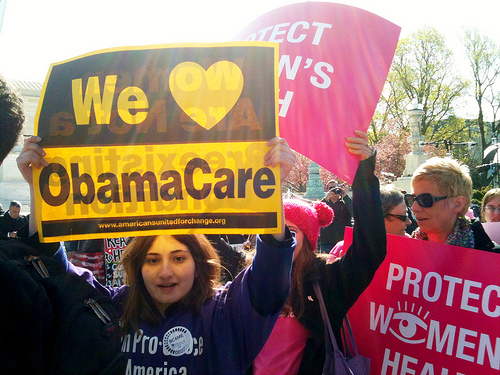Or possibly ever

The Associated Press reports on a little-known benefit of the Affordable Care Act for low-income pregnant women:
Lower-income women who signed up for a private policy in the new insurance exchanges will have access to additional coverage from their state’s Medicaid program if they get pregnant. Some women could save hundreds of dollars on their share of hospital and doctor bills.
Medicaid already pays for nearly half of U.S. births, but this would create a way for the safety-net program to supplement private insurance for many expectant mothers.
Officials and advocates say the enhanced coverage will be available across the country, whether or not a state expands Medicaid under the health law. However, states have different income cutoffs for eligibility, ranging from near the poverty line to solid middle class.
This adds to an impressive list of benefits for women now included in all insurance policies thanks to Obamacare that I feel the need to list because this law’s benefits are so vast and typically marginalized by maniacs ranting against birth control:
Well-woman visits: This includes an annual well-woman preventive care visit for adult women to obtain the recommended preventive services, and additional visits if women and their health care providers determine they are necessary to deliver those services. These visits will help women and their health care providers determine what preventive services are appropriate, and set up a plan to help women get the care they need to be healthy.
Gestational diabetes screening: This screening is for women 24 to 28 weeks pregnant, and those at high risk of developing gestational diabetes. It will help improve the health of mothers and babies because women who have gestational diabetes have an increased risk of developing type 2 diabetes in the future. In addition, the children of women with gestational diabetes are at significantly increased risk of being overweight and insulin-resistant throughout childhood.
HPV DNA testing: Women who are 30 or older have access to high-risk human papillomavirus (HPV) DNA testing every three years, regardless of Pap smear results. Early screening, detection, and treatment have been shown to help reduce the prevalence of cervical cancer.
STI counseling: Sexually active women have access to annual counseling on sexually transmitted infections (STIs). These sessions have been shown to reduce risky behavior in patients, yet only 28 percent of women aged 18-44 years reported that they had discussed STIs with a doctor or nurse.
HIV screening and counseling: Sexually active women have access to annual HIV screening and counseling on HIV. Women are at increased risk of contracting HIV/AIDS. From 1999 to 2003, the Centers for Disease Control and Prevention reported a 15 percent increase in AIDS cases among women, and a 1 percent increase among men.
Contraception and contraceptive counseling: Women with reproductive capacity have access to all Food and Drug Administration-approved contraceptive methods, sterilization procedures, and patient education and counseling, as prescribed by a health care provider. Abortifacient drugs are not included. Contraception has additional health benefits like reduced risk of cancer and improving the health of mothers-to-be.
Breastfeeding support, supplies, and counseling: Pregnant and postpartum women have access to comprehensive lactation support and counseling from trained providers, as well as breastfeeding equipment. Breastfeeding is one of the most effective preventive measures mothers can take to protect their health and that of their children, according to the Centers for Disease Control and Prevention (CDC). One of the barriers for breastfeeding is the cost of purchasing or renting breast pumps and nursing related supplies.
Interpersonal and domestic violence screening and counseling: Screening and counseling for interpersonal and domestic violence will be covered for all adolescent and adult women. An estimated 25 percent of women in the United States report being targets of intimate partner violence during their lifetimes. Screening is effective in the early detection and effectiveness of interventions to increase the safety of abused women.
Conservatives like to pretend they’re baffled when people who believe in choice — like Hilary Clinton — celebrate motherhood, even though we’ve devoted our lives to improving care for women and children.
I often point out that the biggest difference between pro-choice and pro-lifers is that pro-choicers is that pro-choicers actually prevent abortions, as abortions are more common and more deadly when they’re illegal.
Thanks in part to Obamacare both abortions and teenage pregnancies are at new lows — even though more 18 and 19 year-olds are having sex.
If the right’s definition of being pro-life weren’t so perverse — if it included caring for pregnant mothers and newborns and children denied the care that should be a given in the richest country in the world — conservatives would see Obamacare is the most pro-life piece of legislation in American history.
[Photo by LaDawna Howard | Flickr]



